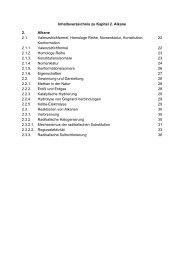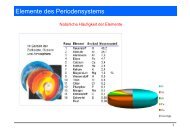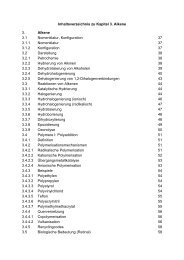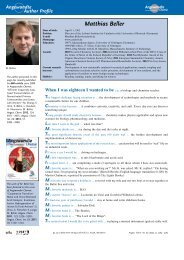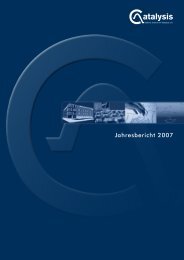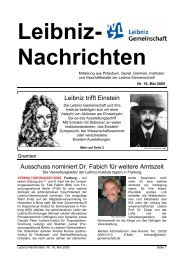An Overview of the Department's Activities - Leibniz-Institut für ...
An Overview of the Department's Activities - Leibniz-Institut für ...
An Overview of the Department's Activities - Leibniz-Institut für ...
Erfolgreiche ePaper selbst erstellen
Machen Sie aus Ihren PDF Publikationen ein blätterbares Flipbook mit unserer einzigartigen Google optimierten e-Paper Software.
Bereich Koordinationschemische Katalyse<br />
Dr. Perdita Arndt<br />
Themenleiterin<br />
Tel.: (0381) 1281 – 162<br />
Fax: (0381) 1281 – 51162<br />
perdita.arndt@catalysis.de<br />
Katalyse früher Übergangsmetalle<br />
Catalysis <strong>of</strong> Early Transition Metals<br />
68 t-Bu) (M = Ti, Zr, Hf) mit Lewis-Säuren, wie z. B. (i-Bu) AlH metallacycles for catalytic applications to compare <strong>the</strong> influence<br />
2 69<br />
Ziel<br />
Im Fokus unserer Untersuchungen stehen katalytische Reaktionen<br />
von Metallocen- Komplexen der frühen Übergangsmetalle<br />
(Ti, Zr, Hf). Ausgehend von komplexchemischen Kenntnissen<br />
sollen neuartige katalytische Reaktionen entwickelt und damit<br />
eine enge Verbindung zwischen Grundlagenergebnissen und<br />
praktischer <strong>An</strong>wendung geschaffen werden.<br />
Ergebnisse<br />
Von besonderem Interesse sind in jüngster Zeit drei-, vier- oder<br />
fünfgliedrige Metallaringsysteme, die vielfach als Intermediate<br />
in katalytischen Reaktionen diskutiert werden.<br />
Für ungewöhnliche gesättigte als auch ungesättigte fünfgliedrige<br />
all-C-Metallaringsysteme der frühen Übergangsmetalle Ti,<br />
Zr und Hf wie Metallacyclocumulene (1-Metallacyclopenta-<br />
2,3,4-triene) sowie Metallacyclopentine (1-Metallacyclopent-<br />
Kooperationspartner:<br />
Pr<strong>of</strong>. E. D. Jemmis,<br />
Bangalore (Indien)<br />
Pr<strong>of</strong>. H. J. Breunig,<br />
Universität Bremen<br />
Pr<strong>of</strong>. H. Lang, TU Chemnitz<br />
Purpose<br />
We are interested in catalytic reactions <strong>of</strong> metallocene complexes<br />
<strong>of</strong> early transition metals (Ti, Zr, Hf). On <strong>the</strong> basis <strong>of</strong><br />
novel results in coordination and complex chemistry catalytic<br />
reactions are developed to link basic research and applications.<br />
Results<br />
We focussed on syn<strong>the</strong>sis, formation and reactions <strong>of</strong> three,<br />
four and five membered metallacycles (alkynes, cycloallenes,<br />
cumulenes), which are important as intermediates for various<br />
catalytic applications.<br />
The formation and reactivity <strong>of</strong> saturated and unsaturated fivemembered<br />
all-C-metalla cycles <strong>of</strong> early transition metals Ti,<br />
Zr und Hf like metallacyclocumulenes (1-metallacyclopenta-<br />
2,3,4-trienes) and metallacyclopentynes (1-metallacyclopent-<br />
3-ynes), were investigated in detail and various examples were<br />
3-ine), sind Bildung und Reaktionen hinlänglich bekannt und<br />
aus unserem Arbeitskreis mit Beispielen belegt. Nun ist mit der<br />
Syn<strong>the</strong>se und Charakterisierung eines Zircona-2,5-disilacyclopent-3-ins<br />
[1] durch Einführung eines zweiten Heteroatoms (Si)<br />
im Ring neben den genannten all-C-Varianten ein stabiler Heterocyclus<br />
beschrieben worden.<br />
Der Übergang zu kleineren Metallacyclen führt zu einer größeren<br />
Ringspannung, besonders wenn kumulierte Doppel- oder<br />
Dreifachbindungen im Ring auftreten. Erst jetzt gelang daher<br />
die Syn<strong>the</strong>se, Isolierung und vollständige Charakterisierung eines<br />
formalen viergliedrigen Titanaheterocycloallens, der durch<br />
eine externe Komplexierung mittels einer zweiten Metalloceneinheit<br />
stabilisiert wird. [2]<br />
Reaktionen der Metallocenalkinkomplexe des Titans und Zirconiums<br />
mit Carbodiimiden führen zur Bildung fünfgliedriger<br />
Ringsysteme sowie C-C-Bindungsknüpfungen. [3] Im Gegensatz<br />
dazu sind mit Azobenzol unerwartete Bindungsaktivierungen<br />
beobachtet worden. [4]<br />
Umsetzungen von Metallacyclocumulenen Cp 2 M(η 4 -t-Bu-C 4 -<br />
und B(C 6 F 5 ) 3 , dienen als Modellreaktionen <strong>für</strong> die Aktivierung<br />
derartiger Verbindungen <strong>für</strong> katalytische <strong>An</strong>wendungen und ermöglichen<br />
vergleichende Betrachtungen über den Einfluss der<br />
verschiedenen Metalle. [5]<br />
Oligocyclopentadienyl-Komplexe des Titanocens und Zirkonocens<br />
werden mit ferrocenylsubstituierten Alkinen und 1,3-Butadienen<br />
erhalten.<br />
Literatur<br />
Fünfgliedrige all-C-Metallacylen – Five-membered<br />
all-C-metallacycles<br />
[1] M. Lamač, A. Spannenberg, H. Jiao, S. Hansen, W. Baumann,<br />
P. Arndt, U. Rosenthal, <strong>An</strong>gew. Chem. 2010, 122, 2999; <strong>An</strong>-<br />
gew. Chem, Int. Ed. 2010, 49, 2937; M. Lamač, A. Span-<br />
nenberg, W. Baumann, H. Jiao, C. Fischer, S. Hansen,<br />
P. Arndt, U. Rosenthal, J. Am. Chem. Soc. 2010, 132, 4369.<br />
[2] O. Theilmann, M. Ruhmann, A. Villinger, A. Schulz, W. W.<br />
Seidel, K. Kaleta, T. Beweries, P. Arndt, U. Rosenthal, <strong>An</strong>gew.<br />
Chem. 2010, 122, 9469; <strong>An</strong>gew. Chem. Int. Ed. 2010,<br />
49, 9282.<br />
Metalla-hetero-cyclocumulene,-cycloalkine, viergliedrige Metallahetero-cycloallene<br />
– Metalla-hetero-cyclocumulenes,-cycloalkynes,<br />
four-membered metalla-hetero-cycloallenes<br />
described. As shown recently by our group, <strong>the</strong> insertion <strong>of</strong> ano<strong>the</strong>r<br />
heteroatom into <strong>the</strong> metallacycle, e. g. silicon, increased<br />
<strong>the</strong> stability <strong>of</strong> such strained systems and givesrise to <strong>the</strong> formation<br />
<strong>of</strong> a zircona-2,5-disilacyclopent-3-yne. [1]<br />
Decreasing <strong>the</strong> ring size leads to increased steric strain especially<br />
when cumulated double or triple bonds are part <strong>of</strong> small<br />
metallacycles. For <strong>the</strong> first time <strong>the</strong> syn<strong>the</strong>sis, isolation and full<br />
characterization <strong>of</strong> a formal four-membered titanaheterocyclallene<br />
was successful. The final product <strong>of</strong> this reductive coupling<br />
reaction <strong>of</strong> a carbodiimide and <strong>the</strong> titanocene alkyne complex<br />
Cp 2 Ti(η 2 -Me 3 SiC 2 SiMe 3 ) is a bimetallic complex. [2]<br />
The reactions <strong>of</strong> <strong>the</strong>se metallocene alkyne complexes <strong>of</strong> titanium<br />
and zirconium with carbodiimides results in <strong>the</strong> formation<br />
<strong>of</strong> five-membered ring systems and C-C coupling reactions, respectively.<br />
[3] With azobenzene unexpected bond activations<br />
were obtained. [4]<br />
Reactions <strong>of</strong> five-memberd metallacyclocumulenes Cp 2 M(η 4 -t-<br />
Bu-C 4 -t-Bu) (M = Ti, Zr, Hf) with <strong>the</strong> Lewis acids (i-Bu) 2 AlH and<br />
B(C 6 F 5 ) 3 can serve as model reactions for <strong>the</strong> activation <strong>of</strong> such<br />
<strong>of</strong> different metals. [5]<br />
Novel oligocyclopentadienyl complexes were syn<strong>the</strong>sized using<br />
ferrocenylsubstituted alkynes and buta-1,3-diynes.<br />
[3] K. Kaleta, M. Ruhmann, O. Theilmann, T. Beweries, S. Roy,<br />
P. Arndt, A. Villinger, E. D. Jemmis, A. Schulz, U. Rosenthal,<br />
J. Am. Chem. Soc. 2011, 133, 5463.<br />
[4] K. Kaleta, P. Arndt, T. Beweries, A. Spannenberg, O. Theil-<br />
mann, U. Rosenthal, Organometallics 2010, 29, 2604.<br />
[5] V. V. Burlakov, T. Beweries, K. Kaleta, V. S. Bogdanov,<br />
P. Arndt, W. Baumann, A. Spannenberg, V. B. Shur,<br />
U. Rosenthal, Organometallics 2010, 29, 2367.




